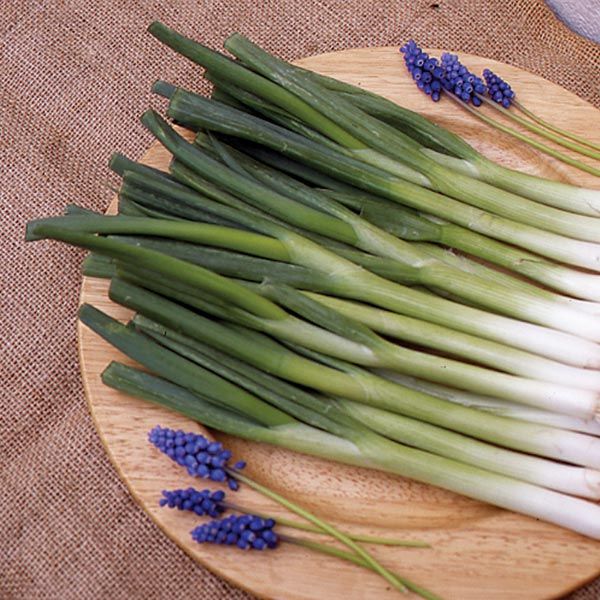Plants of Distinction
Onion Guardsman Salad Vegetable Seeds
Available weeks
44
45
46
47
48
49
50
51
52
1
2
3
4
5
6
7
8
9
10
11
12
13
14
15
16
17
18
19
20
21
A very distinct cross which combines the qualities of both parents. Vigorous roots maintain the upright 'guardsman' habit of the leaves and this in turn produces a slick bulbless salad onion for summer or autumn.
€3.92
In stock
A very distinct cross which combines the qualities of both parents. Vigorous roots maintain the upright 'guardsman' habit of the leaves and this in turn produces a slick bulbless salad onion for summer or autumn.
| SKU | WW-903 |
|---|---|
| Country of Manufacture | United Kingdom |
| Brand | Plants of Distinction |
| Scientific name | Allium fistulosum |
| Common name | Spring Onion |
| Seeds/packet | 500 |
| Germination (days) | 10-20 dgr |
| Sowing depth | 1 cm |
| Plantavstånd | 2 cm mellan plantorna och 45-60 cm mellan raderna. |
| Exposure | Full Sun |
| Cultivation Advice | There are several different types of onion that can be grown successfully from seed including bulbing, bunching and spring varieties. By choosing the right types and sowing at the right time you can have a steady supply of onions practically all year long. Growing onions from seed rather than sets (or immature onions) requires a longer growing season, but the crops are less prone to bolting (flowering to produce seed) and the range of varieties avaialable is more extensive. When harvesting onions for storage, don't bend the ageing tops over! Allow the bulbs to mature naturally and lift when the foliage is almost dry. Store bulbs in a well ventilated area, with temperatures between 0-8oC, do not allow them to freeze. Bulbing onions are the most common culinary onion, usually round, globe shaped or elongated bulbs with yellow, brown or white skin and white or pink flesh. Bulbing onions are widely used raw in salads, or cooked in a whole range of dishes, the flavour, size and storage capabilities varies between varieties. Open, fertile, well draining soil is essential to produce bulbing onions, drainage is especially important for overwintered crops. Cloches can be used to warm the soil prior to sowing. Early crops can be sown indoors, into trays or modules, during late winter at a temperature of 10-15oC. Main crop sowings should be made in early spring into warm, dry soil. Sow onion seed thinly into rows 25-30cm apart and then thin out the seedlings in stages. A maincrop sowing will provide fresh onions from mid-summer onwards, with storage onions being lifted in late summer. Overwintering varieties should be sown in August allowing them to reach a height of 15-20cm by mid autumn. Much taller than this and they may bolt in spring, much shorter and they may not survive the winter. Spacing dictates the final bulb size, for a good crop of medium sized onions space 5cm apart and allow 25cm between rows, and for larger bulbs space 10cm apart in 25cm rows. Pickling onions, also known as cocktail onions or silverskins are bulb onions grown at a high density to provide small onions suitable for pickling. Pickling onions are best direct sown in early to mid spring for harvesting late summer. Salad or Spring Onions are also known as scallions or bunching onions. These varieties are grown as much for their green leaves as for their small bulbs, they are used mainly in salads, Oriental recipes and as garnishes. Spring onions are sown from early spring to early summer, successive sowing every 2-3 weeks ensures a constant fresh supply throughout the season. Overwintered crops of hardy varieties can be sown in mid to late summer for harvesting the following spring. Salad onions grow best in similar soil conditions to bulbing onions but only require a spacing of 1cm between plants and 30cm between rows. Sowing depth should be approximately 2cm. Shallots are small mature bulbs that multiply to form clusters of small bulbs. Shallots have a wide range of culinary uses and can be used raw, cooked or pickled. Shallots can be planted outside from February onwards, spaced 15cm apart and allowing 30cm between rows. Harvest from July to August when the foliage turns yellow. |
| Skörd(x) | Salladslöken, som är ganska okänslig för frost, skördas långt in på senhösten och är bland det första att skörda på våren. Hela löken dras försiktigt upp så snart den nått ätbar storlek. De tidigast sådda och utplanterade lökarna blir nästan lika tjocka som purjo och kan förvaras på samma sätt. Men de håller sig bäst om de får stå kvar i jorden och det är bara på vintern, då de fryser fast, som man inte kan njuta dessa delikatesser. |
| Harvest | August |
| Näring | Vitamin C. |
| Medicinal | Det sägs att det finns antiinflammatoriska egenskaper i lök |
| Care | Easy |
| KRAV marked | No |
| Language on package | English |
| Brand | Plants of Distinction |
| Kort om odling | Sås direkt på friland när jorden reder sig. Vattna jorden före sådd och håll fuktigt under grotiden. Sås upprepade gånger för tillgång hela säsongen. Kan även förkultiveras inomhus i såjord mars-april. Täck sådden med klar plast försedd med lufthål. Utplanteras efter avhärdning när frostrisken är över. Skördas efterhand. |
| Height | 30-40 cm |
| Storage | Keep your seeds in a cool, dry and dark place. |
Write Your Own Review

